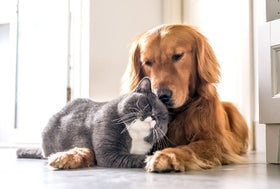
Everything you wanted to know about pet insurance
Why might you need pet insurance? According to Datamonitor, 1 in 3 pets experience an unexpected health issue each year, and those unexpected visits can be pretty costly. Let us help you understand how pet insurance works, and whether or not it's right for you.
WHAT IS PET INSURANCE?
If your buddy gets hurt or sick and need veterinarian care, pet insurance can help cover the costs. Your insurance provider reimburses you for a percentage of your pet’s treatment costs, which can make getting veterinary care for your pet (or pets) more affordable.
HOW DOES PET INSURANCE WORK?
Basically, once you’re covered by a pet insurance provider, you get treatment for your pet and then later you’ll file a claim for reimbursement. So what will you pay? It depends on the policy you have, but generally you’ll pay a deductible when you visit your vet, and then a co-pay of 10% to 30% of the bill after you’ve paid your deductible. Your pet insurance provider pays the remaining 70% to 90%.
WHICH POLICY IS BEST FOR ME?
There are a few options for you to choose from when requesting a quote from a pet insurance company:
- Your annual coverage allowance (how much will the plan cover during a policy year)
- The amount of your deductible (how much you need to pay before your insurance starts paying)
- The percentage of the reimbursement (how much will the provider pay, after you’ve met your deductible)
Here are some other questions you might want to ask yourself before deciding which plan is right for you:
Do I have more than one pet?
If you do, a high-deductible plan might be best so you can keep your monthly premiums lower, but you’ll pay more of the vet bill should one of your pets get hurt or sick.
Do I have money saved?
If you don’t have money set aside for just such an emergency, then a low-deductible might be the way to go. Sure, you’ll pay more on your annual premium, but you’ll need to pay less out of pocket before the plan begins covering expenses.
Do I want pet insurance for emergencies or to cover the costs of regular care?
If you’re thinking you’d like pet insurance as “just in case” emergency coverage, you’ll probably want a lower premium plan with a higher deductible. Just make sure you have the savings to pay the deductible should you need it. For regular care, go the opposite way: a higher premium plan with a lower deductible. If you have a pet or a particular breed that needs a lot attention, this will allow you to pay less per visit.

WHAT I DON’T WANT IN MY PET INSURANCE POLICY
There are a few conditions providers may want to place on your policy. We’d suggest trying to negotiate to have these policy conditions waived, or you may want to consider another provider:
- Limited coverage for hereditary or curable pre-existing conditions
- Paying a set amount paid per condition, and not paying on the actual amount you paid for treatment
- Cancer coverage is an additional cost
- No dental coverage or limited dental coverage
- Veterinarian exam or diagnoses fees are excluded from coverage
OTHER QUESTIONS I SHOULD ASK
When you have a talk with a provider rep, you might want to ask about the following concerns as well:
- What are the waiting periods before a claim can be covered?
- Will my reimbursement include the cost of the vet exam to diagnose the illness or injury?
- Are there limits on how much my policy will pay for a specific condition, either during the policy year or over the lifetime of my pet?
- Are there age limits for coverage?
- Are chronic conditions covered year after year or is there a limit to how much the insurance will pay for a single condition over the lifetime of my pet?
- Are alternative and complementary therapies (like acupuncture or physical rehab) covered?
- Are prescription medications fully covered (including veterinarian-recommended supplements)?
You are now armed with great knowledge about pet insurance plans and policies, and knowledge is power. Make your decision based on your own pet's needs.





